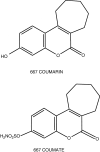Pharmacokinetics of the nonsteroidal steroid sulphatase inhibitor 667 COUMATE and its sequestration into red blood cells in rats
- PMID: 15328524
- PMCID: PMC2409900
- DOI: 10.1038/sj.bjc.6602130
Pharmacokinetics of the nonsteroidal steroid sulphatase inhibitor 667 COUMATE and its sequestration into red blood cells in rats
Abstract
Breast cancer is a major cause of mortality in Western countries and there is an urgent requirement for novel treatment strategies. The nonsteroidal sulphatase inhibitor 667 COUMATE inhibits hepatic steroid sulphatase and growth of oestrone sulphate stimulated tumours in the nitrosomethylurea-induced rat mammary model. Other compounds that contain an aryl sulphamate moiety, for example, oestrone-3-O-sulphamate, are sequestered into red blood cells (RBCs). The aims of this study were to determine the pharmacokinetics of 667 COUMATE and to investigate its sequestration into RBCs. We administered a single p.o. or i.v. dose (10 mg kg(-1)) of 667 COUMATE to rats and used a high-performance liquid chromatography method to measure the levels of the agent and its putative metabolites in plasma. 667 COUMATE had a bioavailability of 95% and could be detected in plasma for up to 8 h. Using two independent analytical methods, we demonstrated that 667 COUMATE is sequestered by RBCs both ex vivo and in vivo. Previous investigations have revealed that 667 COUMATE is rapidly degraded in plasma ex vivo. In this study, we demonstrate that 667 COUMATE is stabilised due to its sequestration into RBCs. In conclusion, the pharmacological efficacy and high oral bioavailability of 667 COUMATE may be partly a consequence of the ability of RBCs to both protect the agent from metabolic degradation and facilitate its transport to tissues. These data support the further clinical evaluation of this novel endocrine therapeutic agent.
Figures





Similar articles
-
Steroid sulphatase inhibitors for breast cancer therapy.J Steroid Biochem Mol Biol. 2003 Sep;86(3-5):423-32. doi: 10.1016/s0960-0760(03)00353-4. J Steroid Biochem Mol Biol. 2003. PMID: 14623540 Review.
-
Potent active site-directed inhibition of steroid sulphatase by tricyclic coumarin-based sulphamates.Chem Biol. 2000 Oct;7(10):773-91. doi: 10.1016/s1074-5521(00)00023-5. Chem Biol. 2000. PMID: 11033081
-
The role of steroid sulphatase in regulating the oestrogenicity of oestrogen sulphamates.Biochem Biophys Res Commun. 2004 Sep 10;322(1):217-22. doi: 10.1016/j.bbrc.2004.07.108. Biochem Biophys Res Commun. 2004. PMID: 15313194
-
Development of a sensitive high-performance liquid chromatography method for the detection of 667 COUMATE in vivo.J Steroid Biochem Mol Biol. 2003 Feb;84(2-3):337-42. doi: 10.1016/s0960-0760(03)00047-5. J Steroid Biochem Mol Biol. 2003. PMID: 12711020
-
SULFATION PATHWAYS: Steroid sulphatase inhibition via aryl sulphamates: clinical progress, mechanism and future prospects.J Mol Endocrinol. 2018 Aug;61(2):T233-T252. doi: 10.1530/JME-18-0045. Epub 2018 Apr 4. J Mol Endocrinol. 2018. PMID: 29618488 Review.
Cited by
-
A pharmacological mouse model suggests a novel risk pathway for postpartum psychosis.Psychoneuroendocrinology. 2016 Dec;74:363-370. doi: 10.1016/j.psyneuen.2016.09.019. Epub 2016 Sep 28. Psychoneuroendocrinology. 2016. PMID: 27728876 Free PMC article.
-
Tetrahydroisoquinoline Sulfamates as Potent Microtubule Disruptors: Synthesis, Antiproliferative and Antitubulin Activity of Dichlorobenzyl-Based Derivatives, and a Tubulin Cocrystal Structure.ACS Omega. 2019 Jan 31;4(1):755-764. doi: 10.1021/acsomega.8b02879. Epub 2019 Jan 9. ACS Omega. 2019. PMID: 30775645 Free PMC article.
-
Host modulation therapy for improving the osseointegration of dental implants under bone healing-suppressed conditions: a preclinical rodent-model experiment.J Periodontal Implant Sci. 2024 Jun;54(3):177-188. doi: 10.5051/jpis.2301800090. Epub 2023 Oct 11. J Periodontal Implant Sci. 2024. PMID: 37857517 Free PMC article.
-
Discovery and Development of the Aryl O-Sulfamate Pharmacophore for Oncology and Women's Health.J Med Chem. 2015 Oct 8;58(19):7634-58. doi: 10.1021/acs.jmedchem.5b00386. Epub 2015 Jun 12. J Med Chem. 2015. PMID: 25992880 Free PMC article.
-
Crystal structure of human carbonic anhydrase II at 1.95 A resolution in complex with 667-coumate, a novel anti-cancer agent.Biochem J. 2005 Feb 1;385(Pt 3):715-20. doi: 10.1042/BJ20041037. Biochem J. 2005. PMID: 15453828 Free PMC article.
References
-
- Abbate F, Winum J-Y, Potter BVL, Casini A, Montero J-L, Scozzafava A, Supuran CT (2004) Carbonic anhydrase inhibitors: X-ray crystallographic structure of the adduct of human isoenzyme II with EMATE, a dual inhibitor of carbonic anhydrases and steroid sulfatases. Bioorg Med Chem Lett 14: 337–341 - PubMed
-
- Baerlocher GM, Beer JM, Owen GR, Meiselman HJ, Reinhart WH (1997) The antineoplastic drug 5-fluororacil produces echinocytosis and affects blood rheology. Br J Haemotol 99: 426–433 - PubMed
-
- Bernstein L, Ross RK (1993) Endogenous hormones and breast cancer. Epidemiol Rev 15: 48–65 - PubMed
-
- Casini A, Antel J, Abbate F, Scozzafava A, David S, Waldeck H, Schafer S, Supuran CT (2003) Carbonic anhydrase inhibitors: SAR and X-ray crystallographic study of the interaction of sugar sulphamates/sulfonamides with isozymes I, II and IV. Bioorg Med Chem Lett 13: 841–845 - PubMed
-
- Elger W, Palme H-J, Schwarz S (1998) Novel estrogen sulphamates: a new approach to oral hormone therapy. Exp Opin Invest Drugs 7: 575–589 - PubMed
MeSH terms
Substances
LinkOut - more resources
Full Text Sources
Other Literature Sources
Medical

